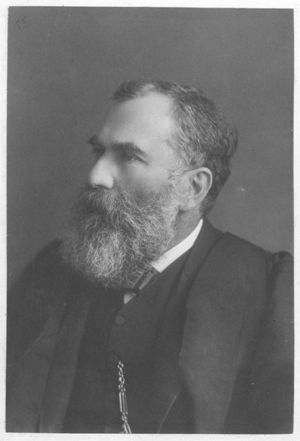Henry Martyn Taylor, FRS
 1843-1927. Senior Proctor. Mathematician, who extended the Braille alphabet to geometric and trigonometric terms.
1843-1927. Senior Proctor. Mathematician, who extended the Braille alphabet to geometric and trigonometric terms.
Taylor was educated at Wakefield and at Trinity, which he entered as a minor scholar in 1861. He graduated BA as third wrangler in 1865, and was awarded the second Smith's prize in 1866.
He cherished for a time the intention of going to the bar, and was in fact called by Lincoln's Inn in November 1869, but soon relinquished the plan. After holding the post of vice-principal of the School of Naval Architecture and Marine Engineering at Kensington (1865-9), he returned to Cambridge in 1869 as assistant tutor on the mathematical staff of Trinity. He had been elected a Fellow, under the old competitive system, in 1866. Thereafter his life was spent in the service of the College and University until his retirement in 1894. He became Tutor in 1874, and held the position for the usual period of ten years.
Taylor's mathematical leanings were mainly towards geometry, in its intuitive aspect, as is indicated by the papers which he contributed to the London Mathematical Society (of which he was one of the earliest members), to the Philosophical Transactions, and the Cambridge Transactions, for example, on inversion, plane curves, and solid geometry. He had a rigid standard of verbal and logical accuracy, and was often consulted by friends, including Lord Rayleigh, on stylistic and other matters.
When released from tutorial duties at the early age of fifty-two, Taylor might reasonably have looked forward to some years of useful mathematical research; however, he soon suffered an attack of influenza which was followed by partial, and later by complete, blindness. He reacted with what contemporaries considered admirable courage. He continued for a time to interest himself in mathematical questions, and indeed his two most original papers, requiring a high degree of constructive imagination, were those which he contributed, after his blindness, to the Philosophical Transactions and to the volume commemorating the jubilee of Sir G. Gabriel Stokes (1900).
Taylor's most notable work, however, arose from consideration of how, with his own special training and personal achievement, he could most usefully help other blind people. He found that although a certain amount of literature was accessible to blind readers through the medium of the Braille script, there was no provision of a scientific kind. Taylor set out to remedy this. He soon made himself expert on the Braille typing machine, and transcribed a series of elementary books on mathematics and various branches of natural science. He was faced with the problem that the Braille system had no provision for mathematical notation, and diagrams posed a special difficulty. Taylor therefore gave much thought to the invention of suitable symbols and contrivances. Reproduction and multiplication of the bulky volumes was costly and, in order to meet this, Taylor, with the assistance of friends, started an Embossed Scientific Books Fund, which was, to his great satisfaction, accepted as a trust by the Royal Society and came to be administered by a committee of the fellows. (Taylor had himself been elected a fellow in June 1898.)
In addition to his scientific and educational interests Taylor had a strong practical sense which found an outlet in the administrative business of his college and, later, in municipal affairs. He was one of the university representatives on the Cambridge town council, was an alderman (1898-1925), and was mayor in 1904.
Taylor was described as ‘singularly modest and devoid of personal ambition … a loyal and generous friend, and a scrupulously fair opponent’ (PRS). Before his blindness, he had been fond of sporting recreations, foreign travel, and mountain excursions. His last few years were clouded by increasing infirmity. He died at his home, The Yews, Newnham, Cambridge, on 16 October 1927. He never married, and left most of his estate to Trinity.
DNB
| Memorial inscription | Translation |
|
MEMORIAE SACRVM HENRICI MARTYN TAYLOR huius collegii per LXI annos socii aliquando lectoris tutorisque, |
Sacred to the memory of Henry Martyn Taylor, Fellow of the College for sixty-one years and at one time Lecturer and Tutor. At the age of fifty-one he lost his sight; but undiscouraged and eagerly he kindled a torch of hope for those who shared his darkness. His invention of new symbols for Braille enabled them to compensate for the loss of their eyes with their fingers and to follow mathematics more clearly than they could have done by any light. Although blind and almost sixty years old he became Mayor of Cambridge, and he dealt with College affairs assiduously to the last. He was born on 6th June 1843 and died on 16th October 1927, being by then Senior Fellow. |
Henry Martyn TaylorBrass located on the south wall of the Ante-Chapel. |
Click on the thumbnail for a larger image. |
|
|
PREVIOUS BRASS |
|
NEXT BRASS Frederick Robert Tennant |
| Brasses A-B | Brasses C-G | Brasses H-K | Brasses L-P | Brasses R-S | Brasses T-W |

